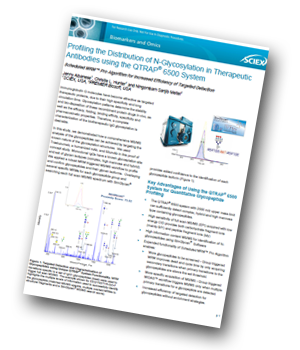 SCIEX has produced an application note demonstrating how a comprehensive MS/MS analysis of glycopeptides can be achieved by targeting the known nature of the glycosylation structures using the QTRAP® 6500 system.
SCIEX has produced an application note demonstrating how a comprehensive MS/MS analysis of glycopeptides can be achieved by targeting the known nature of the glycosylation structures using the QTRAP® 6500 system.
Introduction
Immunoglobulin G molecules have become attractive as targeted therapeutic proteins, due to their high specificity and long circulation time. Glycosylation patterns determine the stability and bio-disposition of these recombinant protein drugs in vivo, as well as the efficacy, folding, binding affinity, specificity and pharmacokinetic properties. Therefore, a complete characterization of the biotherapeutic IgG glycosylation is desirable.
Key Advantages of Using the QTRAP® 6500 System for Quantitative Glycopeptide Profiling
- With its 2000 m/z upper mass limit the system can sufficiently detect complex, hybrid and high mannose type containing glycopeptides.
- High sensitivity of full scan MS/MS (EPI) acquired with low energy CID provides both carbohydrate fragment ions (mainly B/Y) and peptide fragment ions (b/y)
- High information content MS/MS for identification of N-glycopeptides using SimGlycan® Software
- Expanded functionality of Scheduled MRM™ Pro Algorithm enables:
- More glycopeptides to be screened
- More specific acquisition of MS/MS
- Increased efficiency of targeted detection for glycopeptides without enrichment strategies.
Conclusions
In this application note, the feasibility of the Group triggered MIDAS™ workflow was demonstrated for the characterization and profiling of glycopeptides derived from therapeutically relevant antibodies (Trastuzumab and SiluMab) using the QTRAP® 6500 System.
The wide abundance variation in the detected glycopeptides highlights the benefit of using targeted detection on a high sensitivity QTRAP system.




